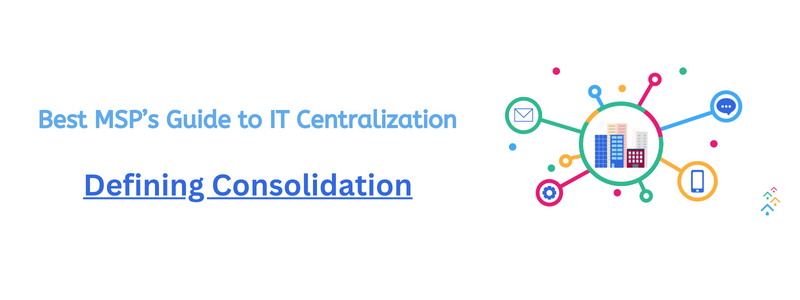The MSP’s Guide to IT Centralization: Defining Consolidation

The MSP’s Guide to IT Centralization
Your staff needs to use a top-of-the-line, all-in-one tech stack to provide customers with the most streamlined, compelling user experience possible. IT centralization is a method of removing redundant components from your stack to improve usability and efficiency while also costing less for you, the MSP.

Why should you expect MSP consolidation
Numerous smaller, regionally concentrated service providers emerged from the conventional IT consulting and technology reseller models. But over the past few years, many technology consulting firms have succeeded by eschewing one-off design and implementation tasks in favor of becoming full-service operators that also oversee the solutions they build.
Consolidation is the real goal of the entire centralized process because this is where the highest cost and efficiency savings can be made by getting rid of outdated platforms.
Your user experience should be more accessible than ever with a freshly consolidated, streamlined core, and you should feel certain that the only tools left in your stack are those that your business needs to succeed.
4 Reasons Consolidation Is Crucial For IT Service Providers
Applications, platforms, and vendor collections within an IT department can over time become disorderly and chaotic, similar to a well-used toolshed. This is particularly true for managed service providers (MSPs), who usually prioritize the needs of their clients before their own.
According to Gaidar Magdanurov, chief success officer of Acronis, Working in a consolidated IT environment also “translates into higher margins and higher profits for the service provider.”
1. Save Money With Streamlined Services
Many service providers consider the technician’s number of hours on each client. “They spend less time on each customer the moment we present a single solution,”
Consolidating IT functions can drive real cost savings. According to research, MSPs with unified IT can save an average of five hours of recovery time.
2. Reduce Human Error
According to research, most MSPs use 14 SaaS solutions from multiple suppliers to meet the needs of their clients. It is common for end users to install their software, leaving networks with vulnerable, blind spots.
This is particularly valid in remote and mixed work settings. MSPs can reduce the risk of human error by centralizing their clients’ application suites.
Fewer errors can mean higher profits for the MSPs, lower costs and higher reliability for their clients.
3. Compete With The Latest Technology
In the IT industry, artificial intelligence is the focus of a new arms race. Ambitious businesses are investing in automation technologies like machine learning, artificial intelligence, and other technology in almost every sector to improve their businesses.
The expense of even entering the competition may be too high for small and midsize businesses. Having a cohesive IT infrastructure is beneficial in this situation as well.
4. Improve Cybersecurity
Cybercriminals often pursue the weakest targets. The majority of MSPs are concerned that they could be the next, according to a study.
Learn more about Cybersecurity: What Is Cyber Security and Is It Really Beneficial?
Employee engagement
Apart from new log-in requests and push alerts with different looks, very nothing may change in the user experience for clients. However, be sure to inform them via emails in advance so they are aware of the changes, how they should react to them, and why it’s good news for them.
Make sure you have additional IT administrators available to respond to any queries or concerns on the day you’re decommissioning the legacy technology.
They ensure that everyone is confidently and frequently utilizing the new core before decommissioning the old one and that they know the date on which their old apps will no longer be accessible.
Final thought
You understand the importance of your MSP to efficiently running your company since you are in charge of your IT partnership. Few businesses today, especially in the era of remote work, can function without technology; This is why buying an MSP may be so nerve-wracking.
We hope that being prepared will make the transition a little less difficult.



